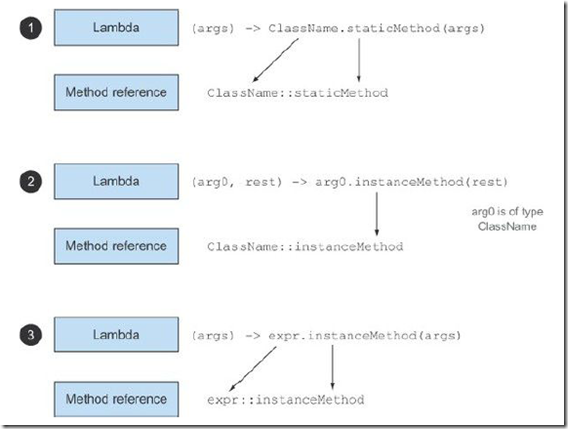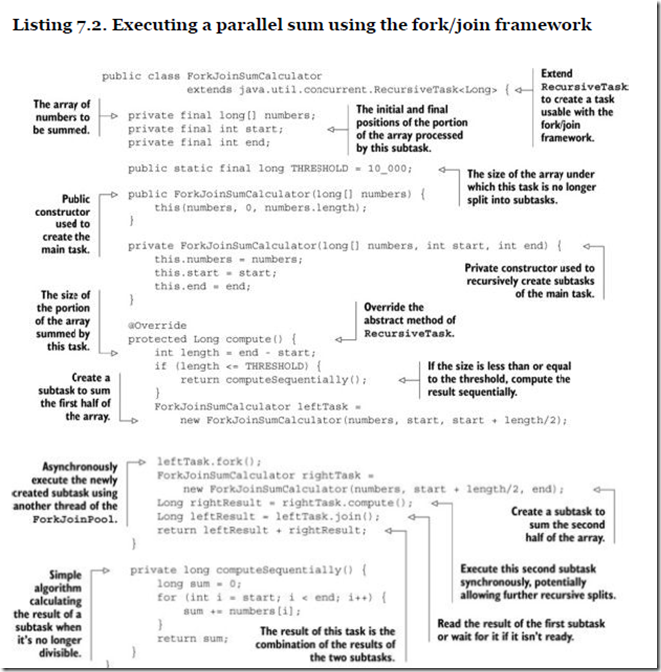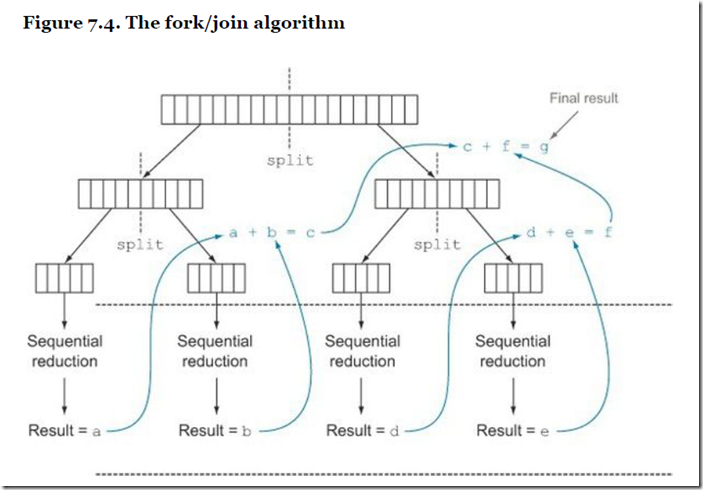Java8 in action
解决的问题:
behavior parameterization,即可以把一段code,逻辑作为参数传入;
这样做的目的,当然为了代码抽象和重用,把变化的逻辑抽象出去;
在java中,如果要实现behavior parameterization,需要通过传入类对象的方式,你首先要声明很多类,verbose
就算你用匿名类的方式,也会大大影响代码的可读性
所以lambda,是function programing的元素,可以将一个匿名函数作为参数传入
Lambdas
A lambda expression can be understood as a concise representation of an anonymous function that can be passed around
Anonymous— We say anonymous because it doesn’t have an explicit name like a method would normally have: less to write and think about!
Function— We say function because a lambda isn’t associated with a particular class like a method is. But like a method, a lambda has a list of parameters, a body, a return type, and a possible list of exceptions that can be thrown.
Passed around— A lambda expression can be passed as argument to a method or stored in a variable.
Concise— You don’t need to write a lot of boilerplate like you do for anonymous classes.

在什么地方可以使用lamda?
So where exactly can you use lambdas? You can use a lambda expression in the context of a functional interface.
In a nutshell, a functional interface is an interface that specifies exactly one abstract method.

可以看到lambda在用法上和匿名类是等价的
Function descriptor
在java8中,有多少种functional interface,
其中function description表示functional的signature,比如Consumer,参数T,无返回值

Predicate,典型的filter场景
The java.util.function.Predicate<T> interface defines an abstract method named test that accepts an object of generic type T and returns a boolean.
- Predicate<String> nonEmptyStringPredicate = (String s) -> !s.isEmpty();
- List<String> nonEmpty = filter(listOfStrings, nonEmptyStringPredicate);
Consumer,消费者场景
The java.util.function.Consumer<T> interface defines an abstract method named accept that takes an object of generic type T and returns no result (void).

Function,transform场景
The java.util.function.Function<T, R> interface defines an abstract method named apply that takes an object of generic type T as input and returns an object of generic type R.

Type inference
用于编译器会做类型check和推导,所以你可以省略参数类型

Using local variables,弱版闭包
- int portNumber = 1337;
- Runnable r = () -> System.out.println(portNumber)
看到lambda,使用临时变量
They’re called capturing lambdas
和闭包的不同是,他有限制,
Lambdas are allowed to capture (that is, to reference in their bodies) instance variables and static variables without restrictions.
But local variables have to be explicitly declared final or are effectively final.
In other words, lambda expressions can capture local variables that are assigned to them only once.

这样会报错,因为你多次修改
我的理解,其实你改不改,对于Java的实现是没有问题,反正都是在你引用的时候,产生一份copy
但是如果你修改了值,容易产生歧义,你会期望引用的值变成你改的值,其实不会
Method references
Method references let you reuse existing method definitions and pass them just like lambdas.
In some cases they appear more readable and feel more natural than using lambda expressions.

You can think of method references as syntactic sugar for lambdas that refer only to a single method because you write less to express the same thing.
一种用于更简单的表示lambda的语法糖
Recipe for constructing method references
There are three main kinds of method references:
1. A method reference to a static method (for example, the method parseInt of Integer, written Integer::parseInt)
2. A method reference to an instance method of an arbitrary type (for example, the method length of a String, written String::length)
3. A method reference to an instance method of an existing object (for example, suppose you have a local variable expensiveTransaction that holds an object of type Transaction, which supports an instance method getValue; you can write expensiveTransaction::getValue)

Constructor references
You can create a reference to an existing constructor using its name and the keyword new as follows: ClassName::new. It works similarly to a reference to a static method.

注意,Apple::new,不是调用new,这个是产生一个function interface,supplier
对于带参数的构造函数,生成的就是function

Useful methods to compose lambda expressions
Composing Comparators

Composing Predicates


Composing Functions


Streams API
To summarize, the Streams API in Java 8 lets you write code that’s
Declarative— More concise and readable
Composable— Greater flexibility
Parallelizable— Better performance
说白,就是以function programming的方式去处理collection,不需要显式的去写迭代,所以declarative
并且,可以透明的处理并行化问题

Streams vs. collections

Working with streams
To summarize, working with streams in general involves three items:
A data source (such as a collection) to perform a query on
A chain of intermediate operations that form a stream pipeline
A terminal operation that executes the stream pipeline and produces a result
Intermediate operations such as filter or sorted return another stream as the return type.
This allows the operations to be connected to form a query. What’s important is that intermediate operations don’t perform any processing until a terminal operation is invoked on the stream pipeline—they’re lazy.


Numeric streams
Mapping to a numeric stream
The most common methods you’ll use to convert a stream to a specialized version are mapToInt, mapToDouble, and mapToLong.

这样可以直接用sum
和下面的写法比较一下,

Converting back to a stream of objects

Numeric ranges

Building streams
Streams from values
Stream<String> stream = Stream.of("Java 8 ", "Lambdas ", "In ", "Action");
Stream<String> emptyStream = Stream.empty();
Streams from arrays

Streams from files

Streams from functions: creating infinite streams


Collecting data with streams
Collectors as advanced reductions
List<Transaction> transactions = transactionStream.collect(Collectors.toList());



Parallel data processing and performance
通过parallel来打开并行

sequential(),可以切换到串行
这里的并行是由fork/join来实现的
fork/join framework
The fork/join framework was designed to recursively split a parallelizable task into smaller tasks and then combine the results of each subtask to produce the overall result.
可以理解成local的map reduce
It’s an implementation of the ExecutorService interface, which distributes those subtasks to worker threads in a thread pool, called ForkJoinPool.
在java7中,我要这样写fork/join应用,比如一个简单的并行求和

注意在compute中,我们会判断阈值,如果不满足,就不断的二分,并递归的调用
然后,这样调用
- public static long forkJoinSum(long n) {
- long[] numbers = LongStream.rangeClosed(1, n).toArray();
- ForkJoinTask<Long> task = new ForkJoinSumCalculator(numbers);
- return new ForkJoinPool().invoke(task);
- }

Spliterator
这是对fork逻辑的抽象
Java 8 already provides a default Spliterator implementation for all the data structures included in its Collections Framework.
Collections now implements the interface Spliterator, which provides a method spliterator.
在Java8中,所有Collections都是实现Spliterator接口
- public interface Spliterator<T> {
- boolean tryAdvance(Consumer<? super T> action);
- Spliterator<T> trySplit();
- long estimateSize();
- int characteristics();
- }
The algorithm that splits a Stream into multiple parts is a recursive process and proceeds as shown in figure 7.6.

split的过程就是不断的调用trySplit
实现WordCount功能的Spliterator


Default methods
Interface如果发生改变,增加function,那么所有实现该interface的类都需要修改以实现新的function,这个太烦躁了;
所以在Java8,给interface加了default methods

Using Optional as a better alternative to null
大家是不是都被NullPointerException烦的不行
需要写出这样丑陋的代码


Java 8 introduces a new class called java.util.Optional<T> that’s inspired by the ideas of Haskell and Scala.
Object value = map.get("key");
写成,
Optional
也可以写成这样,

区别就是of会抛异常
option支持的操作

开始的例子,可以写成,

Java8 in action的更多相关文章
- JAVA8 in Action:行为参数化,匿名类及lambda表达式的初步认知实例整理
import java.util.ArrayList; import java.util.Arrays; import java.util.List; import java.util.functio ...
- Java8 in action(1) 通过行为参数化传递代码--lambda代替策略模式
[TOC] 猪脚:以下内容参考<Java 8 in Action> 需求 果农需要筛选苹果,可能想要绿色的,也可能想要红色的,可能想要大苹果(>150g),也可能需要红的大苹果.基于 ...
- Java8 (1)
参考资料: <Java8 in Action> Raoul-Gabriel Urma 一.jdk8 客观的说,Java8是一次有重大演进的版本,甚至很多人认为java8所做的改变,在许多方 ...
- Java8学习(4)-Stream流
Stream和Collection的区别是什么 流和集合的区别是什么? 粗略地说, 集合和流之间的差异就在于什么时候进行计算.集合是一个内存中的数据结构,它包含数据结构中目前所有的值--集合中的每个元 ...
- Java8中的流操作-基本使用&性能测试
为获得更好的阅读体验,请访问原文:传送门 一.流(Stream)简介 流是 Java8 中 API 的新成员,它允许你以声明式的方式处理数据集合(通过查询语句来表达,而不是临时编写一个实现).这有点儿 ...
- 《Java 8 in Action》Chapter 4:引入流
1. 流简介 流是Java API的新成员,它允许你以声明性方式处理数据集合(通过查询语句来表达,而不是临时编写一个实现).就现在来说,你可以把它们看成遍历数据集的高级迭代器.此外,流还可以透明地并行 ...
- JAVA8初探-让方法参数具备行为能力并引入Lambda表达式
关于JAVA8学习的意义先来贴一下某网站上的对它的简单介绍:“Java 8可谓Java语言历史上变化最大的一个版本,其承诺要调整Java编程向着函数式风格迈进,这有助于编写出更为简洁.表达力更强,并且 ...
- 全网最通透的Java8版本特性讲解
「MoreThanJava」 宣扬的是 「学习,不止 CODE」,本系列 Java 基础教程是自己在结合各方面的知识之后,对 Java 基础的一个总回顾,旨在 「帮助新朋友快速高质量的学习」. 当然 ...
- 专治不会看源码的毛病--spring源码解析AOP篇
昨天有个大牛说我啰嗦,眼光比较细碎,看不到重点.太他爷爷的有道理了!要说看人品,还是女孩子强一些.原来记得看到一个男孩子的抱怨,说怎么两人刚刚开始在一起,女孩子在心里就已经和他过完了一辈子.哥哥们,不 ...
随机推荐
- django admin upload 上传图片到oss Django Aliyun OSS2 Storage
https://github.com/xiewenya/django-aliyun-oss2-storage Install pip install django-aliyun-oss2-storag ...
- ios开发:一个音乐播放器的设计与实现
github地址:https://github.com/wzpziyi1/MusicPlauer 这个Demo,关于歌曲播放的主要功能都实现了的.下一曲.上一曲,暂停,根据歌曲的播放进度动态滚动歌词, ...
- mac通过路径找到对应的文件夹
在finder中 command + shift + G 跳出窗口中输入指定的路径,即可到达.
- VMware Workstation Pro 14.1.1 正式版
VMware是功能最强大的虚拟机软件,用户可以在虚拟机同时运行各种操作系统,进行开发.测试.演示和部署软件,虚拟机中复制服务器.台式机和平板环境,每个虚拟机可分配多个处理器核心.主内存和显存. 更新日 ...
- 【javascript】利用 a 标签自动解析 url
很多时候,我们有从 url 中提取域名,查询关键字,变量参数值等的需求,然而我们可以让浏览器方便地帮助我们完成这一任务而不用写正则去抓取.方法就是先创建一个 a 标签然后将需要解析的 url 赋值给 ...
- spring入门常见的问题及解决办法
在学习spring过程中遇见了种种不同的异常错误,这里做了一下总结,希望遇见类似错误的同学们共勉一下. 1. 错误一 Error creating bean with name 'helloServi ...
- MySQL数据库远程访问权限如何打开(两种方法)
在我们使用mysql数据库时,有时我们的程序与数据库不在同一机器上,这时我们需要远程访问数据库.缺省状态下,mysql的用户没有远程访问的权限. 下面介绍两种方法,解决这一问题. 1.改表法 可能是你 ...
- 小程序url传参如何写变量
<navigator url="../../pages/newsDetail/newsDetail?id={{news.id}}"> <view class=&q ...
- 20 go单元测试
单元测试 Go本身提供了一套轻量级的测试框架.符合规则的测试代码会在运行测试时被自动识别并执行.单元测试源文件的命名规则如下: 必须是以_test.go结尾的文件,比如manager_test.go ...
- hashcode、equals和 ==详解
两个对象值相同(x.equals(y) == true),则一定有相同的hash code: 这是java语言的定义: 因为:Hash,一般翻译做“散列”,也有直接音译为"哈希"的 ...
